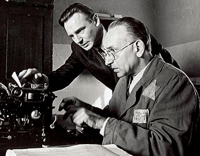 What to leave in, what to leave out? A question many storytellers have asked with every story. How do know what should stay and what should go? There are (at least) two schools of thought here. The first is, “What does the audience like?” The second is, “What serves the story?” The second is much, much harder to live by. I think by now, you can guess which one I espouse. What to leave in, what to leave out? A question many storytellers have asked with every story. How do know what should stay and what should go? There are (at least) two schools of thought here. The first is, “What does the audience like?” The second is, “What serves the story?” The second is much, much harder to live by. I think by now, you can guess which one I espouse.
Here’s a story:
Zero Mostel originated the role of Tevye in the Broadway musical, Fiddler on the Roof. He was, in a word, brilliant…in the beginning. Zero was a great comedic actor. As time went on in the run of the play, he began to do more and more “shtick”; little bits and pieces that had little to do with the play, but got great laughs. It was pure Zero Mostel, and the audiences loved it. One person did not love it; the producer, Hal Prince.
Hal Prince is one of the most successful producers and directors on Broadway. When I attended a workshop he did, one of the most impactful things I heard him say was, “Whatever you do on stage, it must serve the play.” I asked him about Zero’s antics. He was honest, and most gracious in his answer. “I couldn’t prevent him from doing his act on stage, so at the end of his nine-month contract, I didn’t renew it.”
I have never forgotten his words. “Serve the play.” MaryGay Ducey reiterated that sentiment when she once said, “If it doesn’t fit or serve the story, you may have to throw out something you love.”
In a previous article, I spoke of knowing what the story is about (read the "One Sentence" article). Given that maxim, does every part of your story, language, content, gestures, facial expressions; do they serve what the story is about? Is the story about how you can make the audience laugh? Or is it about how a poor, Jewish milkman survives 1904 Russia, and does it with some humor, faith and belief in "Tradition"?
In addition, you need to decide what kind of a story it is. What do I mean by that? Not what type of story, i.e., folktale, fairytale, personal, etc. But, what’s the tenor of your story? Is it tragic; farcical; a romp; or a poignant memoir with humorous moments? Is it cohesive? Does it flow with the same mood throughout?
I recently went to see the movie, Mirror Mirror, a new entry in the resurgence of fairytale stories in movies and on television. Although it had some mildly funny lines and a few interesting plot twists, I was disappointed. It had no clear vision of what it was supposed to be. Was it a spoof, a parody, a love story; I couldn’t tell. It jumped back and forth so much in style, that I was quite distracted. It was as if someone said, "Ooh, let's insert this bit here." It made me think of Zero's shtick.
 Think of the great movie makers (storytellers) like Steven Spielberg, James Cameron, and Frank Capra. Each of their movies had a distinct feel and look. ET and Shindler’s List were two completely different movies, but they each had a clear vision of what their message was, and every part of each film spoke directly to, and about that message. Think of the great movie makers (storytellers) like Steven Spielberg, James Cameron, and Frank Capra. Each of their movies had a distinct feel and look. ET and Shindler’s List were two completely different movies, but they each had a clear vision of what their message was, and every part of each film spoke directly to, and about that message.
 The flavor of each movie was consistent in its content, language, look and feel. The flavor of each movie was consistent in its content, language, look and feel.
Look at each part of your story: content; language; theme; feel; facial expressions; voice tone; pacing, etc. With each piece, you must ask yourself, “Does it fit the style and vision of the story? Is it in synch with all the other parts of the story? Does it serve the story?” If it does, it’s time to share it!
©Mark Goldman 2012
Top of page |